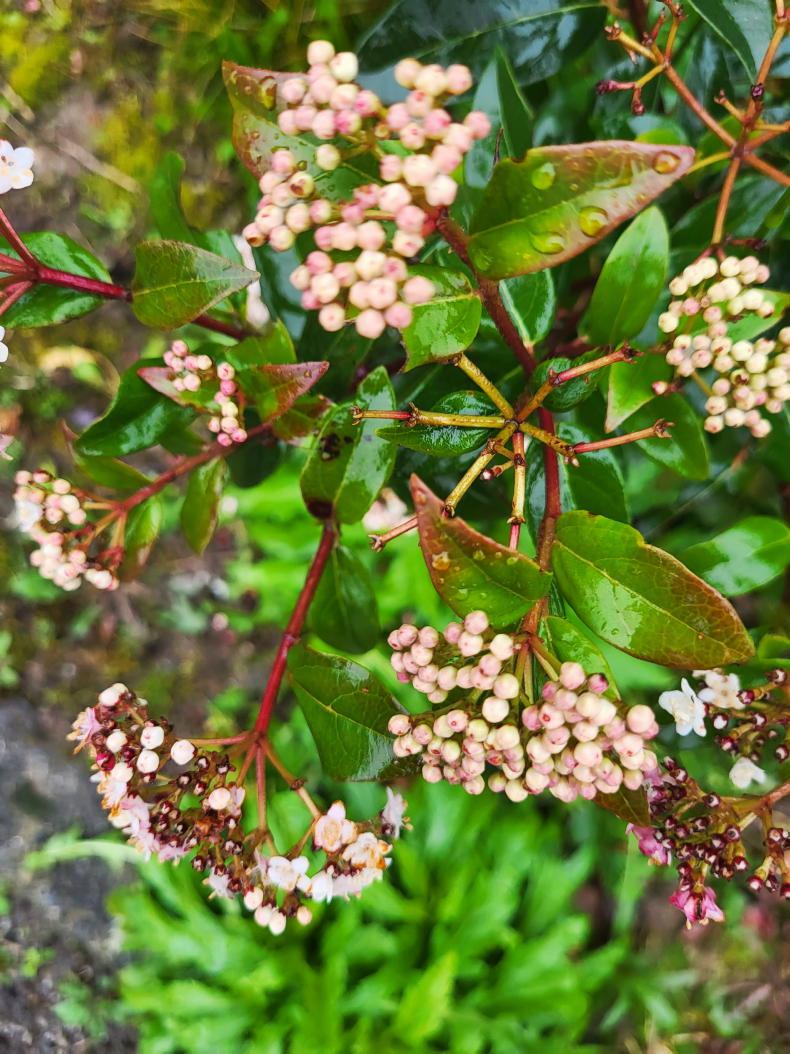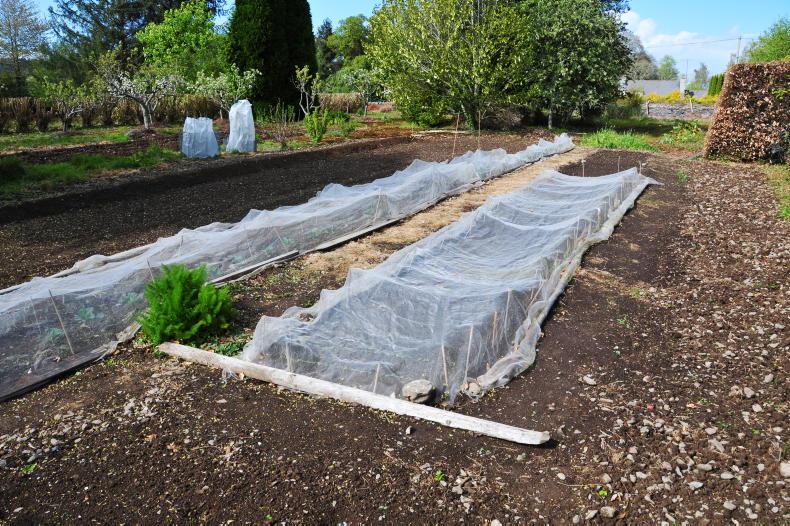Name: The winter-flowering viburnum is also known as laurustinus or laurustine which means ‘resembling bay laurel’ because of the shape of its leaves. However, it is not suitable for cooking.
Botanical name: The botanical name for laurustinus is Viburnum. This is a Latin name for other species of viburnum, which may be spring-flowering too, although there aren’t many that flower for such a long and harsh time of year.
Family: Viburnum is found growing in rocky scrub and in open oak forest. Being evergreen, it can grow in such places during the autumn and early spring when deciduous trees are dormant. It flowers in winter for the same reason and starts producing blue-ish black berries in spring. Although it is Mediterranean in origin, it is hardy, capable of surviving all but the worst winters with ease. Viburnum is related to the Adoxaceae family, the elderberry, which is very similar in appearance, with bunches of young flower buds and later flowers.
Garden value
Generally known as laurustinus, Viburnum tinus has been popular in gardens for centuries, especially in the late 19th century where it was used widely in parks and gardens for its dark-green foliage. Many old gardens still have venerable specimens. Typically, the plant is a large bush or small tree with a dense rounded head of foliage. Over the whole head of the bush, dotted about randomly, the flower clusters appear as a rounded head of small buds, often flushed pink or red. Unlike those of related viburnum species, the flowers mostly have no scent although there may be some plants that have a touch of honey fragrance on a warm day.
Growing laurustinus
Laurustinus is usually grown as a decorative shrub, even if it can get a bit too big for some gardens. It is capable of reaching 3m tall and wide, often more. It can be cut back after flowering to keep it smaller, either cutting back hard or by thinning some shoots each year in late spring.
‘Eve Price’, a more compact version, is the variety most often sold in garden centres. ‘Gwenllian’ is relatively small too with a profusion of relatively large-sized flowers. Both of these versions have relatively small leaves.

Laurustinus.
Viburnum takes clipping well and can be used for hedges and clipped into topiary shapes. It can be cut back to any height and will grow back, even if cut to the ground. This is useful if a hedge gets too big and needs to be reduced.
It is also possible to grow laurustinus as a small free-standing tree, and it looks very pretty trained in this fashion.
Sowing maincrop vegetables
Now is the time to sow main crop vegetables. The term main crop is used to describe the major sowing of seeds for the year, neither very early, nor providing a late crop, both of which are useful to extend the season. The main growing season takes place between March and October, and seeds sown now will have the benefit of the full season.
Among the vegetables that can be sown now are: carrots, peas, broad beans, onions, shallots, cabbage, cauliflower, green broccoli, spring broccoli, parsnips, as well as more unusual vegetables such as celeriac, kohlrabi, bulb fennel and oriental salads.
Before sowing seeds, carefully read the seed packets which detail the plant needs in terms of soil, sunshine, spacing and nutrition. Try to calculate how much of each kind is wanted: most vegetables only last a limited period when ready for harvest before going over. Do not end up with 50 beetroot if only a dozen are needed, because this will be a waste of effort and garden space.
Biomesh, bionet or horticultural fleece can be used to exclude pests such as green fly, cabbage root fly, and carrot fly. It also warms the air around the plants, increasing growth and the quality of the produce grown. Biomesh or bionet, is by no means essential, but it does have very significant advantages. It is available at garden centres and online in a variety of sizes and brands.
Trees, shrubs and roses
Rose bushes and repeat flowering climbers should be pruned now, if not already done. This is a good time to plant deciduous trees, provided the ground is not too wet. Remove ivy from trees before the start of the growing season, except in wild or semi-wild areas as ivy provides habitat to birds and insects.
Flowers
Withered flower stems can be tidied away or they can be left on the soil surface as a mulch. Sow some sweet pea seeds for an early crop of flowers this summer. Divide overgrown herbaceous flowers. Prepare ground, if possible, for sowing hardy annuals.
Fruit, vegetables and herbs
The weather has been wet but digging must wait until conditions are right. Early potatoes get a head start by being sprouted. Sow seeds of early cabbage, cauliflower, carrots, lettuce and onions in a tunnel or glasshouse to get a head-start for planting out.
Lawns
It has been too wet to mow grass but lawns should be mown as soon as conditions allow. If there is heavy moss growth, sulphate of iron lawn moss killer can be applied at this stage, with nitrogen feeding later in spring.
Greenhouse and house plants
Give a good soaking to any plant that is showing growth. Permanent greenhouse plants that have grown too large can be pruned back in the next few weeks. Pollinate glasshouse peaches. Start off begonia, canna lilies and dahlias. Sow bedding plants and tomato seeds.
Read more
Paper bush: fragrance for your garden
Gardening with Gerry: sowing vegetables for beginners - less is more!
Name: The winter-flowering viburnum is also known as laurustinus or laurustine which means ‘resembling bay laurel’ because of the shape of its leaves. However, it is not suitable for cooking.
Botanical name: The botanical name for laurustinus is Viburnum. This is a Latin name for other species of viburnum, which may be spring-flowering too, although there aren’t many that flower for such a long and harsh time of year.
Family: Viburnum is found growing in rocky scrub and in open oak forest. Being evergreen, it can grow in such places during the autumn and early spring when deciduous trees are dormant. It flowers in winter for the same reason and starts producing blue-ish black berries in spring. Although it is Mediterranean in origin, it is hardy, capable of surviving all but the worst winters with ease. Viburnum is related to the Adoxaceae family, the elderberry, which is very similar in appearance, with bunches of young flower buds and later flowers.
Garden value
Generally known as laurustinus, Viburnum tinus has been popular in gardens for centuries, especially in the late 19th century where it was used widely in parks and gardens for its dark-green foliage. Many old gardens still have venerable specimens. Typically, the plant is a large bush or small tree with a dense rounded head of foliage. Over the whole head of the bush, dotted about randomly, the flower clusters appear as a rounded head of small buds, often flushed pink or red. Unlike those of related viburnum species, the flowers mostly have no scent although there may be some plants that have a touch of honey fragrance on a warm day.
Growing laurustinus
Laurustinus is usually grown as a decorative shrub, even if it can get a bit too big for some gardens. It is capable of reaching 3m tall and wide, often more. It can be cut back after flowering to keep it smaller, either cutting back hard or by thinning some shoots each year in late spring.
‘Eve Price’, a more compact version, is the variety most often sold in garden centres. ‘Gwenllian’ is relatively small too with a profusion of relatively large-sized flowers. Both of these versions have relatively small leaves.

Laurustinus.
Viburnum takes clipping well and can be used for hedges and clipped into topiary shapes. It can be cut back to any height and will grow back, even if cut to the ground. This is useful if a hedge gets too big and needs to be reduced.
It is also possible to grow laurustinus as a small free-standing tree, and it looks very pretty trained in this fashion.
Sowing maincrop vegetables
Now is the time to sow main crop vegetables. The term main crop is used to describe the major sowing of seeds for the year, neither very early, nor providing a late crop, both of which are useful to extend the season. The main growing season takes place between March and October, and seeds sown now will have the benefit of the full season.
Among the vegetables that can be sown now are: carrots, peas, broad beans, onions, shallots, cabbage, cauliflower, green broccoli, spring broccoli, parsnips, as well as more unusual vegetables such as celeriac, kohlrabi, bulb fennel and oriental salads.
Before sowing seeds, carefully read the seed packets which detail the plant needs in terms of soil, sunshine, spacing and nutrition. Try to calculate how much of each kind is wanted: most vegetables only last a limited period when ready for harvest before going over. Do not end up with 50 beetroot if only a dozen are needed, because this will be a waste of effort and garden space.
Biomesh, bionet or horticultural fleece can be used to exclude pests such as green fly, cabbage root fly, and carrot fly. It also warms the air around the plants, increasing growth and the quality of the produce grown. Biomesh or bionet, is by no means essential, but it does have very significant advantages. It is available at garden centres and online in a variety of sizes and brands.
Trees, shrubs and roses
Rose bushes and repeat flowering climbers should be pruned now, if not already done. This is a good time to plant deciduous trees, provided the ground is not too wet. Remove ivy from trees before the start of the growing season, except in wild or semi-wild areas as ivy provides habitat to birds and insects.
Flowers
Withered flower stems can be tidied away or they can be left on the soil surface as a mulch. Sow some sweet pea seeds for an early crop of flowers this summer. Divide overgrown herbaceous flowers. Prepare ground, if possible, for sowing hardy annuals.
Fruit, vegetables and herbs
The weather has been wet but digging must wait until conditions are right. Early potatoes get a head start by being sprouted. Sow seeds of early cabbage, cauliflower, carrots, lettuce and onions in a tunnel or glasshouse to get a head-start for planting out.
Lawns
It has been too wet to mow grass but lawns should be mown as soon as conditions allow. If there is heavy moss growth, sulphate of iron lawn moss killer can be applied at this stage, with nitrogen feeding later in spring.
Greenhouse and house plants
Give a good soaking to any plant that is showing growth. Permanent greenhouse plants that have grown too large can be pruned back in the next few weeks. Pollinate glasshouse peaches. Start off begonia, canna lilies and dahlias. Sow bedding plants and tomato seeds.
Read more
Paper bush: fragrance for your garden
Gardening with Gerry: sowing vegetables for beginners - less is more!







 This is a subscriber-only article
This is a subscriber-only article









SHARING OPTIONS: